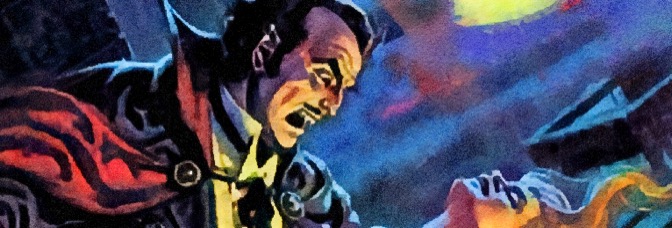
The secret to Doug Moench on Dracula Lives is the art. Tony DeZuñiga does a great, sometimes sketchy, always emotive style for their story this issue, and it’s fantastic. The art’s moody enough to sell Moench’s more turgid exposition.
They’re on the first story, which takes place in 1809 Transylvania, though the outfits and mannerisms make me wonder if DeZuñiga thought it was 1909, and they moved it back after the art was done. The vampire living in the big scary castle on the mountain keeps killing the town’s wives and daughters, but the mayor and police chief don’t want to hear about it.
One angry husband decides he will not let Dracula have his wife and fights back, with multiple terrible consequences and an excellent cliffhanger. Such good art. So, so good. I’d been impressed with DeZuñiga’s last work on Lives, but this one’s even better. Lots of range.
The magazine continues to suffer format adjustments—less funny text pieces, a letters page—but Gary Gerani’s Dracula A.D. 1972 review fits the Lives review pattern. Gerani gives a lengthy recap of the Hammer Dracula movies, mentioning the one or two he thinks are good, then does a very brief, disappointed review of the subject sequel. It’s a lot of filler for anyone reading Lives regularly.
Then comes the next part of the Bram Stoker adaptation by Roy Thomas and Dick Giordano. Giordano excels at drawing Victorian Good Girl art but can’t manage to draw a dog close-up. It’s an outlier panel in an otherwise gorgeous entry.
The action has moved to England, where Mina is writing in a new journal all about how much she misses her fiancé, Jonathan Harker, and why doesn’t he write more. She’s staying with her newly engaged friend Lucy, who’s taken to sleepwalking. It’s standard Dracula adaptation fare, but Giordano’s enthusiastic, and the chapter’s the first to really engage with the novel’s epistolary style. First Mina’s journal, then a newspaper report about the ship crashing. It’s one of the most successful entries, even if the source novel’s prose ain’t great.
The following story is a tedious sixteen-page story from Steve Gerber, Bob Brown, and “Crusty Bunkers.” It’s not a Dracula story; it’s a Lilith, Daughter of Dracula, story. My bad for reading things out of order, but at least this way, I know I don’t want to backtrack and read Vampire Tales for Gerber’s Lilith stories. Lilith is a Marvel attempt at a sexy female vampire who lusts for male blood. It’s very awkward wish fulfillment.
Lilith’s a good guy, though, beating up Mongols who interrupt Village hippies’ acoustic sets. This story has her getting involved in the problems of her human host’s boyfriend. He’s been framed; it’s up to Lilith to save the day. Or night, as it were.
Gerber writes a lot. A lot. Some of the action is good, but the endless exposition and Lilith’s tepid characterization are big minuses. Then there’s the art. Brown clearly needs a strong inker, and even though the Bunkers were Neal Adams, Bob McLeod, Terry Austin, and Russ Heath, apparently their Voltron combination was not what the art needed. As a result, it feels amateurish at times.
Not a strong finish to an outstanding issue—the best in a while, but also the most accomplished.
Though it does remind me to read Giant-Size Chillers in-line with my Tomb of Dracula read-through.
I also forgot the two-page finale: uncredited Moench script, uncredited Win Mortimer art. It’s in the style of a fifties horror quickie but way too overwritten by Moench. They obviously should’ve gotten DeZuñiga to even him out.

Leave a Reply to Vernon WCancel reply